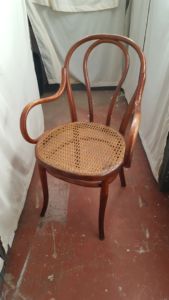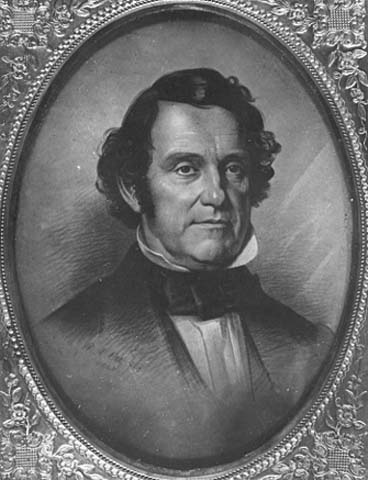
December 13, 2016
By Mara Taft, collections volunteer
This chair was used by Franklin Steele (1813-1880), a founder of Minneapolis and prominent in the lumber industry.
Stylistically, this a bentwood chair with a cane bottom. Manufactured by the Thonet company in Germany, this chair is signed with the original Thonet company mark. Michael Thonet, founder of the Thonet cabinetry company, was one of the most important innovators of bentwood furniture making. He patented a process of gluing layers of wood together through veneer and lamination, and then bending them under heat to created curved back-rails and legs on chairs, headboards, and sofa arms. By 1900, the popular, inexpensive furniture style was widely produced by furniture manufacturers in the United States.

Steele was a founder of Minneapolis who became wealthy through the lumber industry and land deals. Born in Pennsylvania, he heard of prosperity in Minnesota and traveled there via the steamboat Burlington in 1838. He went to Fort Snelling, and at the age of 25, became the storekeeper.
In 1837, both sides of the Mississippi River were controlled by the government and was occupied by 150 squatters. In 1838, Fort Snelling commander Joseph Plympton convinced the government to put the east side of the river up for settlement. Steele staked his claim on the best spot of land by arriving to the site before dawn on the first day of settlement, thus securing his claim over St. Anthony Falls and his prominent role in the Minnesota lumber industry. A dam was built in 1848 blocking the east half of the river, allowing him to catch lumber sent downstream from the north. In 1854, squatters were able to purchase the west side of the river, and thus built a dam on the west side. This dam created, along with Steele’s, created an inverted-V shape which can still be seen today.
Apart from logging, Steele was known for many other building projects in what is now Minneapolis. In 1849 he plotted the town of St. Anthony, which was incorporated with Minneapolis in 1872. In 1852, he built a suspension bridge linking Minneapolis and Nicollet Island. Being an entrepreneur, he charged a toll of 5 cents per pedestrian, 25 cents per wagon, and 2 cents per pig and sheep to cross the bridge. Additionally, in 1851, he donated 4 acres in St. Anthony which was used to build the beginnings of the University of Minnesota.
Through his prominent roles in the lumber industry and land deals, Franklin Steele was undoubtedly an important figure in the emergence of Minneapolis as a prominent city. He helped to build Minneapolis and Hennepin County sitting on this very chair!
To volunteer at HHM, contact volunteer@hennepinhistory.org or 612.870.1329.
